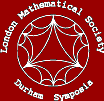| Luis Alday (Princeton/Utrecht) | Tuesday 21st August 09:30 |
| Gluon Scattering Amplitudes at Strong Coupling |
|
|
| Nathan Berkovits ( IFT- State Univ. of Sao Paulo) | Friday 24th August 14:30 |
| Multiloop superstring amplitudes using the pure spinor formalism |
| Using the pure spinor formalism, multiloop superstring
amplitudes can be computed in a manifestly d=10 super-Poincare covariant
manner. This simplifies computations and allows vanishing theorems
to be proven by counting fermionic zero modes. |
|
| Zvi Bern (UCLA) | Friday 24th August 16:00 |
| Multi-loop scattering amplitudes in maximally supersymmetric gauge and gravity theories. |
| Advances in perturbative calculations of loop-level gauge and gravity scattering amplitudes will be described. For the case of maximally supersymmetric gauge theory an all-order resummation of MHV amplitudes will be presented. For N = 8 supergravity, evidence for perturbative ultraviolet finiteness will be given.
Some comments on the remarkably simple structures found in twistor space will also
be made.
|
|
| Rutger Boels (University of Oxford) | Wednesday 22nd August 11:00 |
| Twistors in action |
| Up to recently the word 'twistor' was almost synonymous with 'on-shell'. Based on joint research with Lionel Mason and David Skinner I want to show that this is a misconception by explicitly constructing actions on twistor space. The construction will be shown to be closely connected to harmonic superspace methods, although here no supersymmetry is needed. As a prime application, 'MHV rules' will be derived for all four dimensional quantum field theories with matter having spin less than or equal to 1. |
|
| Bernard de Wit (Utrecht) | Thursday 23rd August 17:15 |
| Maximal supergravities and M-theory degrees of freedom |
| We present an overview of deformations of the maximal supergravities and relate them to M-theory degrees of freedom. |
|
| Jacques Distler (Austin) | Thursday 23rd August 16:15 |
| Orientifolds and Twisted KR Theory |
I will discuss some recent work with Greg Moore and Dan Freed on the topological formulation of orientifolds. In particular, we derive a formula for the background D-brane charge in an orientifold background. Consistency requires that this background charge be cancelled, not just rationally (previous cohomological formulae captured the rational part), but integrally.
If I have time, I'll discuss some applications of our formalism to string backgrounds of current interest. |
|
| Louise Dolan (University of North Carolina) | Friday 24th August 09:30 |
| Tree and Loop Amplitudes in Open Twistor String Theory |
| We compute the one-loop gluon amplitude for the open twistor
string model of Berkovits, using a symmetric form of the vertex operators.
We will discuss the classical solutions in various topologies and
instanton sectors
and the canonical quantization of the world sheet Lagrangian.
We derive the N-point functions for the gluon tree and one-loop amplitudes,
and calculate a general one-loop expression for the current algebra.
This is work done in collaboration with Peter Goddard, hep-th/0703054.
|
|
| Michael Green (University of Cambridge) | Monday 20th August 09:30 |
| Properties of four-graviton scattering in string theory and supergravity |
|
|
| Andrew Hodges (University of Oxford) | Monday 20th August 16:15 |
|
Twistor diagrams and Yang-Mills scattering amplitudes |
| I will start with the basic contour integrals in Roger Penrose's original theory, explain the connection with the BCF recursion relation for tree-level amplitudes, and give a new picture of one-loop amplitudes. |
|
| Chris Hull (Imperial College, London) | Thursday 23rd August 09:30 |
| Twistor Strings and Gravity |
|
|
| Jerzy Lukierski (Inst for Theor Phys. Univ Wroclaw, Poland) | Tuesday 21st August 14:00 |
| Composite Twistor Structures in Standard Superstring Theory |
|
|
| Tim Morris (Southampton University) | Wednesday 22nd August 09:30 |
| Completing MHV rules via Equivalence Theorem evasion |
| We demonstrate that the canonical change of variables that yields the MHV lagrangian, also provides contributions to scattering amplitudes that evade the equivalence theorem. This `ET evasion' in particular provides the tree-level (-++) amplitude, which is non-vanishing off shell, or on shell with complex momenta or in (2,2) signature, and is missing from the MHV (aka CSW) rules. At one loop there are ET-evading diagrammatic contributions to the amplitudes with all positive helicities. We supply the necessary regularisation in order to define these contributions (and quantum MHV methods in general) by starting from the light-cone Yang-Mills lagrangian in D dimensions and making a canonical change of variables for all D-2 transverse degrees of freedom of the gauge field. In this way, we obtain dimensionally regularised three- and four-point MHV amplitudes. Returning to the one-loop (++++) amplitude, we demonstrate that its quadruple cut coincides with the known result, and show how the original light-cone Yang-Mills contributions can in fact be algebraically recovered from the ET-evading contributions. We conclude that the canonical MHV lagrangian, supplemented with the extra terms brought to correlation functions by the non-linear field transformation, provide contributions which are just a rearrangement of those from light-cone Yang-Mills and thus coincide with them both on and off shell.
|
|
| V.Parameswaran Nair (CUNY New York) | Thursday 23rd August 11:00 |
| Comments on Yang-Mills theory with Twistorial Overtones |
|
|
| Sir Roger Penrose (University of Oxford) | Monday 20th August 11:00 |
| Cosmological Twistors |
|
|
| Radu Roiban (Penn State) | Monday 20th August 17:15 |
| Integrability in N=4 SYM: an overview |
|
|
| Christian Saemann (Dublin Institute for Advanced Studies) | Thursday 23rd August 14:00 |
| Matrix Models in twistor String Theory |
|
|
| David Skinner (University of Oxford) | Friday 24th August 11:00 |
| Heterotic twistor-string theory |
| I'll discuss recent work with Lionel Mason which reformulates twistor-string theory as a heterotic string. This clarifies why conformal supergravity arises and provides a link between the Berkovits and Witten pictures. |
|
| George Sparling (University of Pittsburgh) | Tuesday 21st August 14:45 |
| The Xi Transform |
|
|
| Stephan Stieberger (Max-Planck-Institut für Physik) | Monday 20th August 14:00 |
| Supersymmetry Relations and MHV Amplitudes in Superstring Theory |
|
|
| Tomasz Taylor (Northeastern University) | Monday 20th August 14:45 |
| Noncommutative Fields in Twistor-like spaces |
|
|
| Gabriele Travaglini (QMUL) | Tuesday 21st August 16:15 |
| Scattering amplitudes, MHV diagrams, and Wilson loops |
|
|
| Anastasia Volovich (Brown University) | Tuesday 21st August 11:00 |
| Multiloop Gluon Amplitudes and AdS/CFT |
|
|
| Martin Wolf (Imperial College London) | Tuesday 21st August 17:15 |
| N=8 Self-Dual Supergravity |
| I will talk about recent developments in twistorial
formulations of extended Einstein supergravity theories.
The first part of my talk is devoted to the
supersymmetric generalisation of Ward's extension of
Penrose's non-linear graviton construction. In the second
part, I will discuss the off-shell formulation of N=8
self-dual supergravity on supertwistor space. This talk
is based on work done in collaboration with L. J. Mason. |

